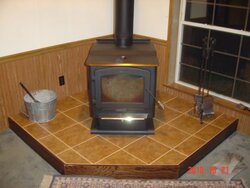This is my first post at hearth.com
I fired-up my new Hearthstone Shelbourne woodstove this afternoon after the break-in burns.
I have the minimum clearances for a corner installation with the rear heat shield and double wall chimney pipe-- 6 inches from the back corners to the wall.
My concern is that the drywall still feels pretty hot. How hot can it safely get? I am afraid I will have to get some wall protection.
Thanks for the anticipated feedback.
I fired-up my new Hearthstone Shelbourne woodstove this afternoon after the break-in burns.
I have the minimum clearances for a corner installation with the rear heat shield and double wall chimney pipe-- 6 inches from the back corners to the wall.
My concern is that the drywall still feels pretty hot. How hot can it safely get? I am afraid I will have to get some wall protection.
Thanks for the anticipated feedback.



